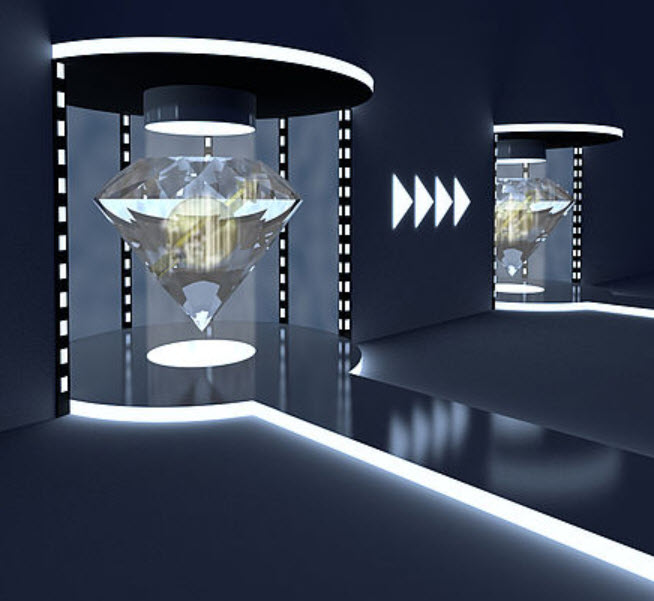Teleporting information achieved by TU Delft
June 2, 2014

Illustration representing quantum information teleportation between diamonds (credit: TU Delft)
Teleporting people through space, as in Star Trek, is impossible by the laws of physics, but researchers at TU Delft‘s Kavli Institute of Nanoscience have succeeded in teleporting information.
Using quantum entanglement, they transferred the information contained in a quantum bit in a diamond to a quantum bit in another diamond three meters away, without the information having traveled through the intervening space.
The results were published in Science May 29.
Hanson’s research group produces qubits using electrons in diamonds. “We use diamonds because ‘mini prisons’ for electrons are formed in this material whenever a nitrogen atom [“nitrogen vacancy center“] is located in the position of one of the carbon atoms. The fact that we’re able to view these miniature prisons individually makes it possible for us to study and verify an individual electron and even a single atomic nucleus.
“We’re able to set the spin (rotational direction) of these particles in a predetermined state, verify this spin, and subsequently read out the data. We do all this in a material that can be used to make chips out of. This is important as many believe that only chip-based systems can be scaled up to a practical technology.”
Quantum internet
The researchers say this development is an important step towards a network for communication between future ultra-fast quantum computers — a “quantum internet” that will enable secure information transfer.
“The distance in our tests was three meters, but in theory the particles could be on either side of the universe,” said the head of the research project, Prof. Ronald Hanson. “The unique thing about our method is that the teleportation is guaranteed to work 100%. The information will always reach its destination, so to speak. And, moreover, the method also has the potential of being 100% accurate.”
Hanson is planning to repeat the experiment this summer over a distance of 1300 meters, with diamonds located in various buildings on TU Delft’s campus. This experiment could be the first that meets the criteria of the “loophole-free Bell test,” and could provide the ultimate evidence to disprove Einstein’s rejection of entanglement. Various other research groups are currently striving to be the first to realize a loophole-free Bell test, which is considered to be the Holy Grail in quantum mechanics.
Abstract of Science paper
Realizing robust quantum information transfer between long-lived qubit registers is a key challenge for quantum information science and technology. Here, we demonstrate unconditional teleportation of arbitrary quantum states between diamond spin qubits separated by 3 m. We prepare the teleporter through photon-mediated heralded entanglement between two distant electron spins and subsequently encode the source qubit in a single nuclear spin. By realizing a fully deterministic Bell-state measurement combined with real-time feed-forward quantum teleportation is achieved upon each attempt with an average state fidelity exceeding the classical limit. These results establish diamond spin qubits as a prime candidate for the realization of quantum networks for quantum communication and network-based quantum computing.